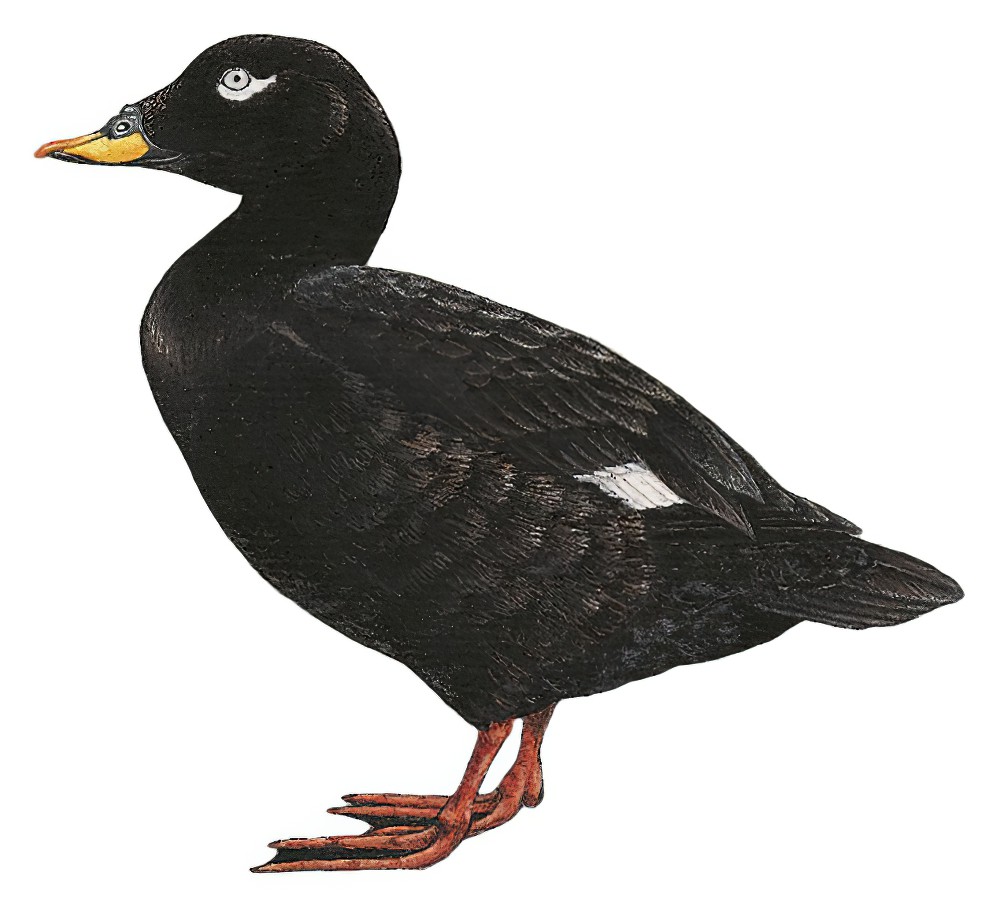Velvet Scoter / Melanitta fusca

Velvet Scoter
SCI Name:
Protonym: Anas fusca Syst.Nat.ed.10 p.123
Taxonomy: Anseriformes / Anatidae / Melanitta
Taxonomy Code: whwsco3
Type Locality: 'Oceano Europaeo''; restricted to coast of Sweden by Linnaeus, 1761, Fauna Svecica, ed. 2, p. 39.
Author: Linnaeus
Publish Year: 1758
IUCN Status: Vulnerable
DEFINITIONS
MELANITTA
(Anatidae; Ϯ Velvet Scoter M. fusca) Gr. μελας melas, μελανος melanos black; νηττα nētta duck; "Familie. Enten, Anas. ... 155. Gattung. Melanitta. 395. nigra. 396. fusca. 397. perspicillata." (Boie 1822); "Melanitta Boie, Isis von Oken, 1822, col. 564. Type, by subsequent designation, Anas fusca Linné. (Eyton, Monogr. Anat., 1838, p. 52.)" (Peters 1931, I, 181).
Var. Melanetta.
Synon. Ania, Maceranas, Macroramphus, Melanonetta, Oidemia, Pelionetta, Phaeonetta.
fusca
L. fuscus dusky, black, brown. Despite its classical meaning this epithet is used in ornithology to indicate a very wide spectrum of colours from black, grey and brown to a range of dark tints including slate-blue and dusky-orange (see also fuscus).
● ex “Héron brun de Cayenne” (= ☼) of d’Aubenton 1765-1781, pl. 858, and “Héron brun” of de Buffon 1770-1786 (syn. Agamia agami).
● ex “Gobe-mouche brun de la Martinique” of d’Aubenton 1765-1781, pl. 568, fig. 2 (Allenia).
● ex “Brown Sandpiper” of Pennant 1768, and Latham 1787 (syn. Calidris minuta).
● ex “Brown Tern” of Latham 1785 (syn. Chlidonias niger).
● ex “Promérops de la nouvelle Guinée” of d’Aubenton 1765-1781, pl. 638, “Promérops brun à ventre rayé” of de Buffon 1770-1783, “Promérops brun de la nouvelle Guinée” of Sonnerat 1776, and “New Guinea brown Promerops” of Latham 1782 (syn. Epimachus fastuosus).
● ex “White-breasted Barbet” of Latham 1782 (Malacoptila).
● "61. ANAS. ... fusca. 5. A. nigricans, macula pone oculos lineaque alarum albis. Anas corpore obscuro, macula alba pone oculos, lineaque alba. Fn. svec. 106. It. gotl. 215. 271. Anas fera fusca. Jonst. av. t. 44. Anas niger. Will. orn. 278. t. 10. Raj. av. 141. Habitat in oceano Europæo. Mas ad basin rostri gibbositate notatus." (Linnaeus 1758) (Melanitta).
● ex “Martin-pêcheur de la Nouvelle Guinée” of d’Aubenton 1765-1781, pl. 663 (= ♀), and “Great Brown Kingsfisher” of Latham 1782 (syn. Melidora macrorrhina).
● ex “Tangara brun d’Amérique” of d’Aubenton 1765-1781, pl. 155, fig. 2 (syn. Paroaria gularis).
● ex “Coot-footed Tringa” of Edwards 1743-1751, “Phalaropus fuscus” of Brisson 1760, and “Brown Phalarope” of Pennant 1785, and Latham 1785 (syn. Phalaropus lobatus).
● ex “Brown Creeper from the South Seas” of Latham 1782 (syn. Phylidonyris undulata).
● ex “Golondrina parda” of de Azara 1802-1805, no. 301 (subsp. Progne tapera).
● ex "Figuier étranger" of d'Aubenton 1765-1781, pl. 58, fig. 3 (Setophaga).
● ex “Bouveron” of de Buffon 1770-1783: “J’appelle ainsi cet oiseau ... parce qu’il me paroît faire la nuance entre les bouvreuils [bullfinches] d’Europe et les bec-ronds [seedeaters] d’Amérique” (syn. Sporophila lineola).
● ex “Barge brune” of d’Aubenton 1765-1781, pl. 875 (syn. Tringa erythropus).
● ex “Rasle brun des Philippines” of Brisson 1760 (Zapornia).
● ex “Tourterelle de la Caroline” of d’Aubenton 1765-1781, pl. 175 (syn. Zenaida macroura carolinensis).
● "96. LOXIA. ... fusca. 25. L. fusca, subtus albida, remigibus a tertia ad nonam basi omnino albis. Chin. Lagerstr. 19. Habitat in Benghala." (Linnaeus 1758) (unident.).
● ex “Figuier brun-olive” of de Buffon 1770-1783, and “Olive-brown Warbler” of Latham 1783, and Pennant 1785 (unident.).
● ex “Gobe-mouche brun de Cayenne” of d’Aubenton 1765-1781, pl. 574, fig. 1 (unident.; has been linked with Cnemotriccus fuscatus and with Contopus cinereus).
UPPERCASE: current genus
Uppercase first letter: generic synonym
● and ● See: generic homonyms
lowercase: species and subspecies
●: early names, variants, mispellings
‡: extinct
†: type species
Gr.: ancient Greek
L.: Latin
<: derived from
syn: synonym of
/: separates historical and modern geographic names
ex: based on
TL: type locality
OD: original diagnosis (genus) or original description (species)












